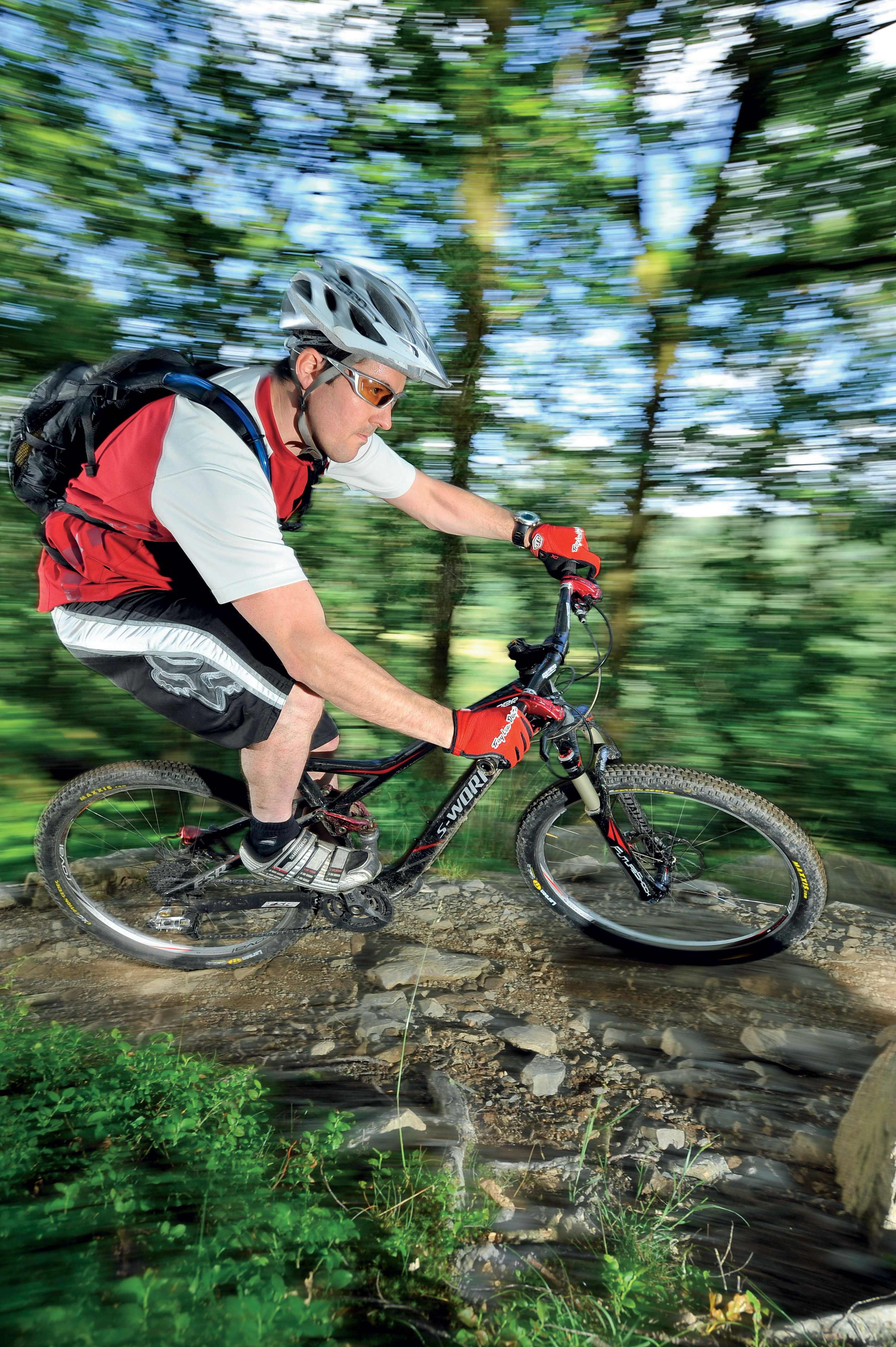 Frame
Frame
The Stumpjumper’s front triangle is built from Specialized’s in-house FACT 10M carbon-fibre, using the Az1 (as one) construction process. This proprietary technique means the individual tubes are laid and cured, then joined together via a carbon wrap before a final finishing cure. The rear seatstay/brake bridge assembly is also fabricated from carbon-fibre and incorporates an aluminium disc mount and derailleur hanger. Specialized has kept to a durable M5 aluminium-welded construction for the chainstays, an area where there is a lot of wear and tear from the chain.
As on the current Enduro, the frame sports a direct mount front derailleur — it’s lighter, simpler to set up and allows Spesh to alter the seat-tube profile for greater stiffness around the bottom bracket. More weight is saved with a magnesium shock link and trick carbon reservoir mount on the chainstay. The end result is a 120mm bike that weighs an amazing 23.94lb with pedals.
Suspension
Slotted into the front of the S-Works is the new Future Shock S120 fork. This has a tapered one-piece carbon-fibre steerer tube/crown assembly, similar to the one on the Trek Remedy, and runs on a 1-1/8in upper bearing and 1.5in lower bearing. A similar bearing set-up is used on the E120, but here it feels a lot more integrated and stiffer. Despite our reservations, the design also doesn’t lock you into using a Specialized fork. Fit a 1-1/8in to 1.5in reducer insert and you can run a conventional fork.
To boost torsional stiffness further, the contact area on the fork dropouts and hub end caps is enlarged. Those of you who’ve been around a while will remember front hubs had oversized axle washers about 10 to 15 years ago. It seems the preoccupation with stanchion diameter and thru-axles means we’ve forgotten the simple ways of making things stiffer. In a straight head-to-head, we’d say the S120 was a stiffer fork than the 15mm Float F120 on the Whyte.
Internally the S120 has the new L-VAS (low volume air spring) and Flow Control Brain Fade damper. These are housed in the same leg using a ‘Buddy System’ which eliminates parts, saving more weight — the S120 is a claimed 3.2lb.
Switching to a new rocker link rear end for 2008 has allowed Specialized to keep the seat-tube intact but also simplify the routing for the remote inertia valve. This has a lighter Trail Tune than the Brain on the Epic but is still adjustable via a Brain Fade dial on top of the remote. The AFR Shock is air sprung with rebound adjustment. Rear travel is identical to the front, at 120mm.
Wheels
Roval is Specialized’s house wheelset brand, and for 2008 it’s now offering two mountain bike wheelsets. The Contrôle XC wheelset fitted here is the top of the range and features an extruded E5 aluminium rim that’s tubeless-ready, DT Swiss-made hubs using a straight pull DoubleDrive spoking pattern and titanium skewers. With 24 DT Revolution spokes on the front and 28 on the rear, the wheels weigh a feathery 1,500g, but to get the weight down Specialized has specced a narrow profile rim. All well and good, but the wheels are flexy, which caused our Maxxis control tyres to roll slightly in turns.
Performance
‘Taut’ is how we’d describe the S-Works. The main frame is rock solid, especially around the head tube, and the suspension feels so firm that it almost encourages you to get stomping out of the saddle with every turn of the pedal — it was a pleasure to ride this bike up the long fire-road at Whinlatter. Cornering is precise and changes in direction are immediate, with none of the squirm we felt riding the Fisher HiFi. The FSR does have a supple, or compliant, ride but the suspension comes into effect on the bigger, harder impacts and square-edge rocks. As with all Brain-equipped bikes we’ve ridden, the rear suspension does snap open, almost as if the Brain detects the impact then breaks away, but it’s not something that slows you down. We also felt more propped up on the S-Works but, with the same Brain technology at both ends, the bike has a very good balance.
The FSR is roomy in the front, and rider weight feels well centred, even though the bike has a long wheelbase and rear wheel bias. Downhill it’s surefooted and ultra stable, but round steep uphill turns we noticed a loss of front wheel traction, especially in slippery mud. Running the fork deeper into its sag does help by steepening the head angle, shortening the wheelbase and placing more weight over the front end, but we do think the FSR is a mite too long and definitely has too high a bar position.
The FSR may be the bike with two Brains, but there are a couple of other things that really aren’t too clever. The 90mm stem is too long on a medium-size trail bike with a 26.25in down-tube, and the handlebars need to be an inch wider. The stem is too high and compounds the problem with the light steering. We also reckon Spesh could add a couple of millimetres to the width of the rims, improving durability without adding much in weight. Lastly, the Magura Marta disc brakes are powerful, but the reach adjustment has a limited range — turn it too far and it unthreads the lever, causing it to rattle.



